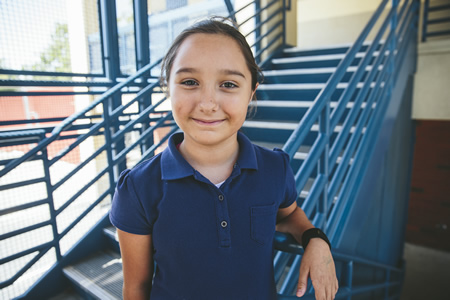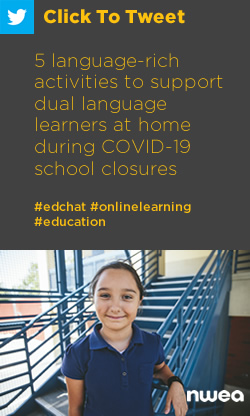Lea este artículo en español.
 Schools in the United States and around the world have made the unprecedented move to online instruction in response to coronavirus school closures.
Schools in the United States and around the world have made the unprecedented move to online instruction in response to coronavirus school closures.
While access to technology, instructional support, and curricula in the online environment are on the minds of many, online and digital learning programs may not be able to offer the kinds of specific, targeted resources English language learners need for language development.
The Spanish Solutions team at NWEA, which develops the content and builds the tests for Spanish MAP® Growth™ and Spanish MAP® Reading Fluency™, wants to help. Many of us are former language teachers, so we reached into our teaching toolboxes for five language-rich ideas that families can use to support English and Spanish learning at home.
These activities do not require technological devices or school supplies, just people, everyday items around the living space, and a desire to practice language skills while having fun together.
Activity 1: Word Games and Alphabet Fun
Try these word and alphabet games to practice letter and vocabulary knowledge, sound recognition, and phonetic development. Take turns coming up with different variations and themes.
- Choose a category (e.g., animals, activities, household items, food). Starting with the letter A, take turns naming things from that category that start with each subsequent letter of the alphabet. Examples:
English: alligator, bear, cat…
Spanish: águila, burro, cocodrilo….
Mix it up: alligator, búho, cat, delfín…
Variation: One person thinks of a word in a category, and the next person uses the last letter of that word to start their word. Examples:
English: alligatoR, RabbiT, Tiger…
Spanish: vacA, AlcE, ElefantE…
Mix it up: conejO, OtteR, RabbiT, TigrE…
- Look around the room and name the first object you see (in either language). Then have children search for other objects that start with that letter. Examples:
English: Letter B: book, box, ball, bread…
Spanish: Letter F: fresa, fruta, flores, fotos…
Mix it up: Letter S: spoon, silla, sugar, sofa…
Activity 2: Words and Vocabulary
Try this vocabulary game to practice vocabulary and learn new words. Many of us write lists to help keep ourselves organized, for example, shopping lists, to-do lists, and lists of books we want to read. Make a list in either language and ask children to find categories or give a title to the list. Help them name the items on the list in both languages.
- For a shopping list, ask children follow-up questions such as, What things are like each other? What do they have in common? Which are round? Which are food? Which are blue?
- For a to-do list, ask children questions such as, Which activities require tools? Which activities are outdoors? Which are indoors? Which can kids do?
Activity 3: Sentence Building and Storytelling
Help children practice grammar and develop sentence-building skills. With this activity, everyone takes turns saying one word to build a sentence. The sentences build to tell a story. This can be combined with physical activity outside, such as bouncing a ball to each person when it’s their turn or jumping after a sentence is complete.
- English example: Person 1 (P1): One. P2: Day. P3: I. P1: Saw. P2: Seven. P3: Cats: P1: Eating. P2: Fish. P3: In. P1: Our. P2: Neighbor’s. P3: Yard.
- Spanish example: Persona 1 (P1): Carlos. P2: Fue. P3: A. P1: Hablar. P2: Con. P3: La. P1: Vecina. P2: Sobre. P3: Los. P1: Zapatos. P2: En. P3: El. P1: Lago. P2: Del. P3. Barrio.
Activity 4: Chatter
Practice dialogues and stories in both languages with simple picture books or comic strips. Read a story or comic strip together. For fun, retell the story or recreate the dialogue in a different way by just using the pictures.
[O]nline and digital learning programs may not be able to offer the kinds of specific, targeted resources English language learners need for language development.”
Variation: You can use a familiar television program or cartoon instead. Turn off the sound and have each person take on the role of a character and invent that character’s dialogue.
Bonus tip: Use closed captioning or subtitles to experiment with different language combinations, such as English dialogue with Spanish subtitles. This is great for building vocabulary, listening, and reading skills.
Activity 5: Learn Something New
 Try this activity to practice describing steps in sequence while also teaching children to help with chores. Is there something someone in your household knows how to do that you’ve always wanted to learn? Is there something that you’ve always wanted to teach others to do? Show each other how to do something like prepare a family recipe, change a flat tire, sew on a button, or do laundry. Help children name and recreate the steps in both languages.
Try this activity to practice describing steps in sequence while also teaching children to help with chores. Is there something someone in your household knows how to do that you’ve always wanted to learn? Is there something that you’ve always wanted to teach others to do? Show each other how to do something like prepare a family recipe, change a flat tire, sew on a button, or do laundry. Help children name and recreate the steps in both languages.
Here’s an example for sewing on a button:
- Find a spare button, thread, a needle, and a piece of cloth or clothing.
- Thread the needle.
- Tie a knot at the end of the thread.
- Place the button on the cloth.
- Put the needle through the bottom of the cloth up through one of the holes in the button.
- Pull the thread through to position the button.
- Put the needle down into the next hole in the button and through the cloth.
- Pull the thread through the bottom to hold the button in place.
- Continue to sew until the button stays in place.
- Tie a knot at the end of the thread when you are finished and cut the thread.
Additional information
We hope these activities can help provide you with opportunities to learn together while also having fun. For more ideas, read “Coronavirus resources for English learners” from Florida International University (in English) and “COVID-19 recursos educativos y buenas prácticas” from Tecnológico de Monterrey (in Spanish).
Special thanks to Spanish solutions specialists Cecilia Gazza Sena and Kayla McLaughlin for their contributions to this post.